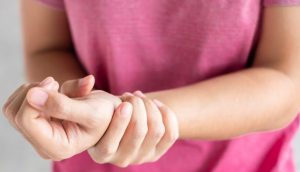
Nội dung bài viết / Table of Contents
This post is also available in: Tiếng Việt (Vietnamese)

Tenosynovitis, also known as tendon sheath inflammation, is an inflammation of a tendon and its sheath.
A tendon is a type of fibrous tissue that connects your muscles to your bones. These tissues help control actions such as running, jumping, grasping, and lifting. Without tendons, you wouldn’t be able to control the movement of your body.
A protective sheath known as the synovium covers tendons. This sheath produces synovial fluid, which keeps the tendon lubricated. Injury to the tendon may result in the malfunction of the sheath.
If this occurs, the sheath may fail to make synovial fluid or it may not make enough fluid. This can cause inflammation or swelling of the sheath.
Please discuss with your doctor for further information.
Certain tendons in the body are more susceptible to injury, primarily those in the hands, feet, and wrists. Tendon sheath inflammation is more common in these areas. However, it can occur in any tendon in the body, including the shoulder, elbow, and knee. If you develop this condition, you may have the following symptoms:
Some people may develop a fever. This indicates the presence of an infection and requires immediate medical attention.
There may be some symptoms not listed above. If you have any concerns about a symptom, please consult your doctor.
If you have any signs or symptoms listed above or have any questions, please consult with your doctor. Everyone’s body acts differently. It is always best to discuss with your doctor what is best for your situation.
Tenosynovitis is typically the result of injury to the tendon or surrounding muscle or bone. It’s not limited to athletes and appears in patients who perform a variety of repetitive-motion activities, such as assembly-line work, weeding, and typing. People working in certain jobs appear to have greater risk of it than others, including:
It’s most common in the tendons of the wrist, hands, and feet. Injury can result from:
Tendon sheath inflammation can also be due to underlying health conditions. Examples of conditions that can result in this condition include:
The cause of the disease can’t be determined in some patients. In rare cases, tendon sheath inflammation is due to an infection that resulted from a cut or puncture to the tendon.
Please consult your doctor for further information.
The information provided is not a substitute for any medical advice. ALWAYS consult with your doctor for more information.
Diagnosis of tenosynovitis will require a physical exam of the affected area. Your doctor will check to see if redness and swelling are present. Your doctor may also ask you to move the affected area to see if pain is present.
In some cases, your doctor may order an ultrasound or MRI to confirm the diagnosis or rule out other possible causes such as arthritis.
The treatment for tenosynovitis focuses on reducing inflammation and pain. One strategy is to rest the affected area and stop the activities that caused the initial injury.
Your doctor may recommend the use of a brace or splint to immobilize the affected area. Applying heat or cold may also help reduce swelling and pain. Other therapies that your doctor may recommend are:
Your doctor may also prescribe medications for tendon sheath inflammation. Over-the-counter non-steroidal anti-inflammatory drugs (NSAIDs), such as ibuprofen, or injectable corticosteroids are other options.
If your condition was caused by an infection, your doctor may prescribe antibiotics to fight the infection. If your condition is due to an underlying health issue, such as rheumatoid arthritis or gout, treatment may also include medications to treat these disorders.
Once the tendon heals, your doctor may recommend exercises or physical therapy to help strengthen the muscle. Strengthening the muscle will help protect the tendon from injury in the future. If you have recurring tendon sheath inflammation, your doctor may recommend surgery to correct the problem.
Tenosynovitis is preventable if you avoid excessive movements or motions that are repetitive or forceful. Muscle strengthening around the site of the joint can also help prevent this type of injury, as well as stretching and range-of-motion (ROM) exercises.
If you cut your hands, wrists, or feet, proper cleaning of the wound will help prevent infection and the possible development of tendon sheath inflammation.
If you have any questions, please consult with your doctor to better understand the best solution for you.
Sources: